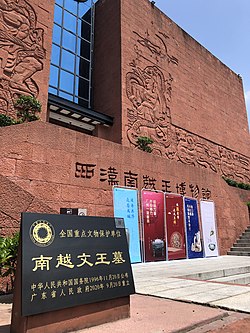The Museum of the Western Han Dynasty Mausoleum of the Nanyue King (Chinese: 西漢南越王博物館 Cantonese: Sai Hon Nam Yuet Wong Mou Bok Mat Gun; Vietnamese: Tây Hán Nam Việt Vương Bác Vật Quán ) houses the 2,000-year-old tomb of the Nanyue King Zhao Mo in Guangzhou.
Museum in Guangzhou, China23°8′15″N 113°15′40″E / 23.13750°N 113.26111°E / 23.13750; 113.26111
| 西漢南越王博物館 | |
 | |
| Established | 1988 |
|---|---|
| Location | Yuexiu District, Guangzhou, Guangdong |
| Type | Mausoleum |
| Museum of the Mausoleum of the Nanyue King | |||||||||||
|---|---|---|---|---|---|---|---|---|---|---|---|
| Traditional Chinese | 西漢南越王博物館 | ||||||||||
| Simplified Chinese | 西汉南越王博物馆 | ||||||||||
| Literal meaning | Western Han Nanyue King Museum | ||||||||||
| |||||||||||
Zhao Mo ruled from 137 BC to 122 BC, and his tomb was discovered in downtown Guangzhou in 1983. The museum, which opened in 1988, showcases the tomb and its complete trove of artifacts. It was named a Major National Historical Site in 1996 and is renowned for its rare assemblage of funerary artifacts representing the diffusion of cultures throughout the Lingnan region during the Han dynasty.
Layout
The mausoleum and museum complex occupies an area of 17,400 m (187,000 sq ft). Hidden 20 meters (65.6 feet) underground, the tomb is made up of 750 huge stones with colorful murals. The over 1,000 pieces of cultural relics, bronzeware and terra cotta ware in particular, feature the Yue Culture of Lingnan (Nanyue Culture). Represented also are traces of central Chinese culture, the Chu culture of south China, the Bashu culture of southwest China, the culture from the northern grassland, and even foreign cultures.
The mausoleum was discovered in 1983 and excavated by archaeologists Mai Yinghao and Huang Zhanyue. The museum opened in 1988. It is 20 meters under Xianggang Shan (Elephant Hill) in Guangzhou on a construction site for a hotel, and was excavated. The tomb is nearly 11 meters long and over 12 meters wide. It is divided in seven parts, with a front chamber, east and west wing rooms, the main coffin chamber, east and west side rooms, and a back storage chamber.
Artifacts


The tomb has yielded more than 1,000 burial artifacts; a chariot, more than 50 cooking implements, among which gold, silver and bronze vessels, trivets, 10 metal swords, musical instruments, such as a set of eight bronze bells, chime bells, stone chimes and a zither with its components, an armored breastplate containing 709 metal plates, shields and spears, and human sacrifices were found (15 courtiers were buried alive with him to serve him in death). It is also among the only tombs of the early Western Han period that has murals on its walls.
The tomb also excavated a unique imperial seal, belonging to that of "Emperor Wen" (Văn Đế), indicating that he styled himself emperor domestically as opposed to a king externally. The large scale of jade pendants worn by the deceased and his wives also amounts to imperial rank.

Alongside Chinese artifacts, pieces from the steppes, and Iranian and Hellenistic Central Asian regions have been found: a Persian silver box found in the tomb is the earliest imported product found to date in China. There were artifacts that were found in which belonged to the Đông Sơn culture of northern Vietnam.
A silk-jade garment made up of 2,291 pieces of jade is the spotlight of the mausoleum. It is acknowledged that jade garments with pieces connected by gold, silver, or copper are not uncommon. But this garment is unique for its jade pieces connected by silk which makes it the only one of its kind in the world. Nor are historical records available to verify other jade garments connected by silk thread. In addition, the style of buttons down the front is unique among unearthed jade garments. This silk-sewn-jade garment shows the early development of jade garments as well as development of the Nanyue culture.
Access
The museum is located at 867 Jiefang Rd. in Yuexiu District in central Guangzhou. It is accessible by bus routes 7, 29, 33, 203, 211, 273, 543, and 552, and by Metro Line 2 to the Yuexiu Park (Exit E).
See also
- List of museums in China
- Nanyue
- Triệu dynasty
- Zhao Mo
- Southward expansion of the Han dynasty
- Nanyue silver box
References
- ^ 南博简介. Museum of the Mausoleum of the Nanyue King. Archived from the original on 2013-06-12. Retrieved 2014-09-08.
- "黄展岳". Institute of Archaeology. 2014-06-05. Retrieved 2019-05-07.
- "Museum of the Western Han Dynasty Mausoleum of the Nanyue King". Archived from the original on 2004-11-07. Retrieved 2008-02-14.
- "History of Museum of the Western Han Dynasty Mausoleum of the Nanyue King". Retrieved 2008-02-14.
External links
- Museum's official site (in English)
- Museum of the Mausoleum of the Nanyue King
- Timeline - World History Documentaries, The Mystery Of The Jade Suit Tomb on YouTube, Mysteries Of China.
| Yuexiu District | |||||||
|---|---|---|---|---|---|---|---|
| Subdistricts | |||||||
| Landmarks | |||||||
| Geography | |||||||
| Transport |
| ||||||
| Education |
| ||||||
| This list is incomplete. École Française Internationale de Canton was previously on Ersha Island | |||||||
| Archaeology museums in China | |
|---|---|


